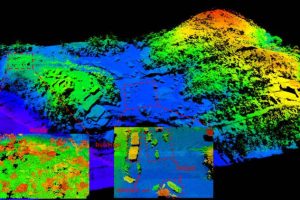
Lasers at IAP HQ
It will be used to measure temperature distributions in mesosphere and lower thermosphere at altitudes between 80 and 110km.
The technique is called Doppler resonance lidar, in which light is back-scattered by tuning the laser to a resonance transition of a metal atom – for example iron at 372 or 386nm, or potassium at 770nm.
Back-scattered returns can be as low as one photon per laser pulse, which is hard enough to detect at night, and especially difficult to find in the daytime when background noise increases 100,000,000x.
The instrument is portable, said by Spectrum to be the only one in the world to be both portable and daylight-capable, partly due to the replacement of flash lamp laser pumps with a novel tunable diode-pumped alexandrite laser.
“The aim of the project is to create compact mobile measurement systems that we can take around the world,” said project leader Dr Josef Höffner. “Such systems require automatic operation under extreme environment conditions like Antarctica without access to them for long periods of times. We therefore need components that are very robust and reliable as well being able to provide the levels of sensitivity, speed and flexibility required under these challenging conditions.”
Background noise suppression comes partly through having an extremely small field of view and optical filtering – requiring the laser to be stabilised for both field of view and wavelength.
“The laser requires a complex and fast real-time stabilisation system with nanosecond timing, according to Spectrum. Its 500 pulses/s 24hours a day are timed by one of the firm’s 20Msample/s M2i.6012 arbitary waveform generator, while conditions within the laser are measured with an 8bit 2.5Gsample/s M4i.2221 digitiser card handling >1Gbyte/s all day with a response time of ~1ms after processing measured data in real-time.
Signals from the backs-cattered light are processed by a 250 Msample/s M4i.4421 16bit digitiser – in total, 21 signals are managed by a software package developed at the IAP.
 Ice breaker unloads mobile lidar at the Australian Antarctic station Davis (69° south)
Ice breaker unloads mobile lidar at the Australian Antarctic station Davis (69° south)
“We have achieved a compact solution by combining fast, flexible electronics with real-time capability,” said Höffner. “Our old system needed a 10ton, 6m container, and this has been shrunk to a 1,500kg system, and we have nearly finished shrinking this even further to fit into a one-meter cubed box of only 250kg, which will use the same electronics and a more compact and advanced laser.”
Höffner presented the results from this project at the International Conference on Space Optics in Greece. – his paper is due to be available from the conference website, according to Spectrum.
 Electronics Weekly Electronics Design & Components Tech News
Electronics Weekly Electronics Design & Components Tech News



